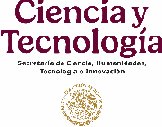
Sesiones grabadas: https://www.youtube.com/channel/UCVpnjTjXDWdEUH6hx-3zY1g
Billiard-Like Robots: Let Them Be Unstable and Unobservable!
- Dr. Steven LaValle
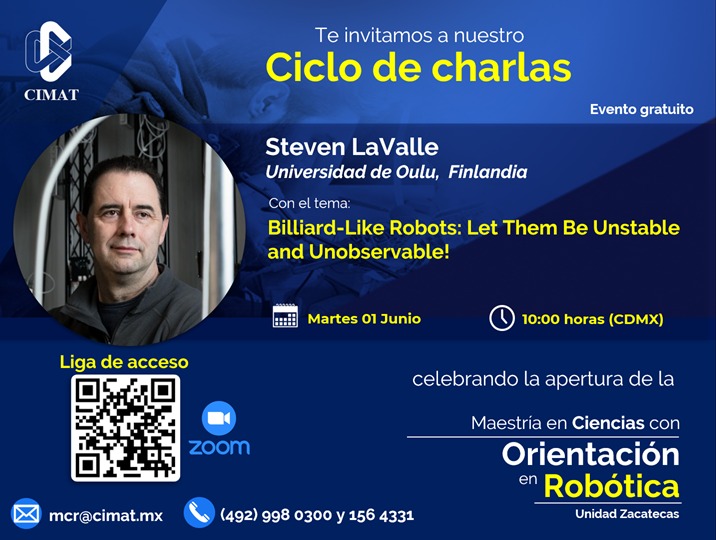
University of Oulu, Finland
Fecha y hora: Martes 01 Junio 2021, 10:00 am (hora central de México)
Resumen
This talk will highlight our work over the past decade on controlling robots by giving them simple rules to reflect off of obstacles in their environment. This line of work pushes the extreme limits of minimalism and is suitable for scenarios where there are limited sensing and actuation capabilities, such as consumer security robots and nanorobotics. We take heavy inspiration from dynamical billiards, a branch of mathematics pioneered by Hadamard, Artin, Sinai, and others, but adapt the bouncing laws to models that are easily achievable by robots and are amenable to algorithmic analysis. Our results include basic conditions for attractors and limit cycles, simple achievement of linear-temporal logic specifications, visibility-based algorithmic analysis, and demonstrations on embarrassingly cheap robot systems. An abundance of simple, open problems remain in this area.
Semblanza
Steven M. LaValle is Professor of Computer Science and Engineering, in Particular Robotics and Virtual Reality, at the University of Oulu, Finland. From 2001 to 2018, he was a professor in the Department of Computer Science at the University of Illinois. He has also held positions at Stanford University and Iowa State University. His research interests include robotics, virtual reality, sensor fusion, planning algorithms, computational geometry, and control theory. In research, he is mostly known for his introduction of the Rapidly exploring Random Tree (RRT) algorithm, which is widely used in robotics and other engineering fields. He also authored the books Planning Algorithms, Sensing and Filtering, and Virtual Reality.
With regard to industry, he was an early founder and chief scientist of Oculus VR, acquired by Facebook for $3 billion in 2014, where he developed patented tracking technology for consumer virtual reality and led a team of perceptual psychologists to provide principled approaches to virtual reality system calibration, health and safety, and the design of comfortable user experiences. From 2016 to 2017, he was a Vice President and Chief Scientist of VR/AR/MR at Huawei Technologies, where he was a leader in consumer product development on a global scale.
http://lavalle.pl/
Ultrasound haptics and levitation: the future of human-computer interaction?
- Dr. Stephen Brewster
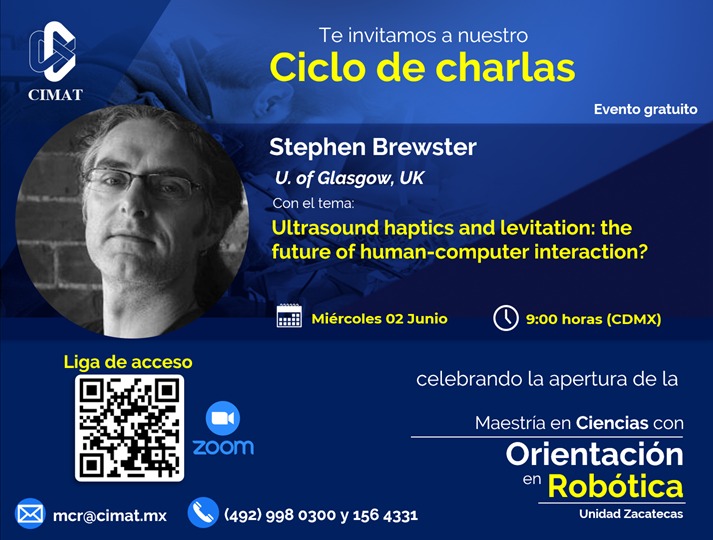
University of Glasgow, UK
Fecha y hora: Miércoles 02 Junio 2021, 9:00am (hora central de México)
Resumen
Ultrasound provides some brand new opportunities for interaction in user interfaces. In this talk, I will describe this new modality and what it offers to HCI. By using standard loudspeakers, we can create soundfields that generate haptic feedback in mid-air, without the user having to hold or touch anything. We can control the position and texture of this feedback in real time. This ‘mid-air’ haptics enables new interaction techniques around devices. I will give examples of how it can be used for virtual controls and how novel interactions can be designed. Another exciting possibility is the use of ultrasound to levitate small particles to create ‘physical’ pixels in the air in front of the user. These physical pixels can be precisely controlled to levitate 3D shapes and objects, which can be controlled dynamically. This opens up many new opportunities for displaying 3D models and data. In the talk, I will describe how to make this highly novel form of display possible and some of the interesting problems that arise around selecting and manipulating the levitated objects.
Semblanza
I am a Professor of Human-Computer Interaction in the Department of Computing Science at the University of Glasgow, UK. My main research interest is in Multimodal Human-Computer Interaction, sound and haptics and gestures. I have done a lot of research into Earcons, a particular form of non-speech sounds.
I did my degree in Computer Science at the University of Herfordshire in the UK. After a period in industry I did my PhD in the Human-Computer Interaction Group at the University of York in the UK with Dr Alistair Edwards. The title of my thesis was "Providing a structured method for integrating non-speech audio into human-computer interfaces". That is where I developed my interests in Earcons and non-speech sound. If you go to my publications list you can get a copy of my thesis, should you want one.
After finishing my PhD I worked as a research fellow for the European Union as part of the European Research Consortium for Informatics and Mathematics (ERCIM). From September, 1994 - March, 1995 I worked at VTT Information Technology in Helsinki, Finland. I then worked at SINTEF DELAB in Trondheim, Norway.
As of the begining of October 1995, I started lecturing in HCI at Glasgow University in the UK. If you want to know anything about what I do then send me an email. I have been hard at work building up a world-class research group in multimodal HCI. You can find out what each of the members of the group is doing from the group homepage.
http://mig.dcs.gla.ac.uk/
Investigación en Robótica en CIMAT
- Dr. Héctor M. Becerra y Dr. Rafael Murrieta-Cid
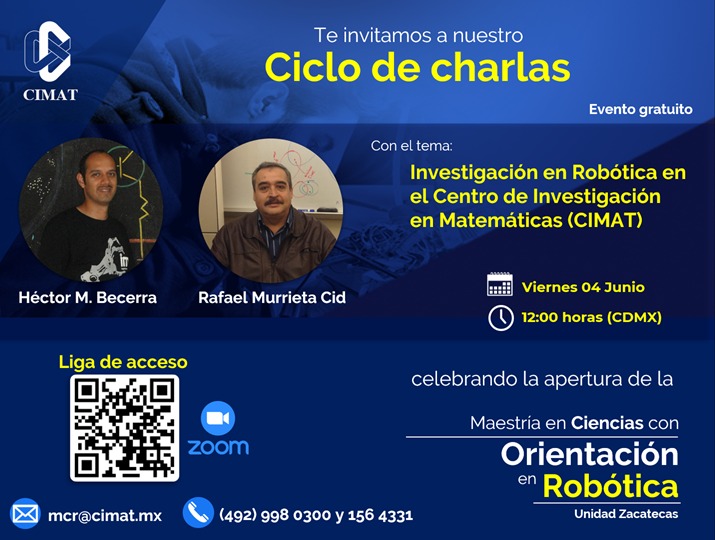
CIMAT Guanajuato
Fecha y hora: Viernes 04 Junio, 12:00pm hora (hora central de México)
Resumen
En esta plática, se presentarán la mayoría de los temas de investigación en robótica que se desarrollan en el CIMAT, por ejemplo control y navegación visual, control óptimo, control distribuido basado en consenso, planificación de movimientos, teoría de estimación y modelos de predicción, robótica probabilística, juegos de persecución-evasión, entre otros. También se presentarán aplicaciones en diferentes sistemas como son robots de ruedas, robots humanoides y drones.
Semblanza del Dr. Héctor M. Becerra
Héctor Becerra recibió el grado en Ingeniería Electrónica por el Tecnológico Nacional de México, campus Ciudad Guzmán, el grado de Maestría en Ciencias en Control Automático por el CINVESTAV, Unidad Guadalajara, y el grado de Doctorado en Ingeniería de Sistemas e Informática por la Universidad de Zaragoza, España, en 2003, 2005 y 2011, respectivamente. Se desempeñó como profesor-investigador en la Universidad de Guadalajara, Centro Universitario de los Valles, y en el ITESM, Campus Guadalajara, entre enero y junio de 2012. Posteriormente se incorporó como investigador del Centro de Investigación en Matemáticas, en el área de Ciencias de la Computación de CIMAT-Guanajuato, siendo titular desde 2017. Actualmente tiene el nombramiento de Investigador Titular B en CIMAT y es miembro del Sistema Nacional de Investigadores nivel I.
Semblanza del Dr. Rafael Murrieta Cid
Él se graduó de Ingeniero Físico en el Tecnológico de Monterrey campus Monterrey (1990), lugar donde también obtuvo una maestría en Sistemas de Manufactura (1993). Obtuvo el doctorado en robótica, en el Instituto Nacional Politécnico de Toulouse Francia en Noviembre de 1998. Su tesis de doctorado la realizó en el grupo de Robótica e Inteligencia Artificial del LAAS-CNRS en Toulouse. En 1998-1999, fue investigador posdoctoral en el departamento de Ciencias de la Computación en la Universidad de Stanford, California. De 2002 a 2004 realizó una segunda estancia posdoctoral en el Instituto Beckman y en el departamento de Ingeniería Eléctrica de la Universidad de Illinois en Urbana-Champaign (UIUC). De 2004 a 2006 fue profesor y director del Centro de Investigación en Mecatrónica, del Tec de Monterrey Campus Estado de México. Desde Marzo del 2006 trabaja en el grupo de Ciencias de la Computación en el CIMAT. Durante el año 2016 realizó una estancia Sabática en UIUC. Él tiene el nombramiento de Investigador Titular C en CIMAT Guanajuato y es miembro del Sistema Nacional de Investigadores Nivel III.
Últimos avances en sistemas autonomos aéreos y submarinos en la UMI LAFMIA del CINVESTAV
- Dr. Rogelio Lozano-Leal
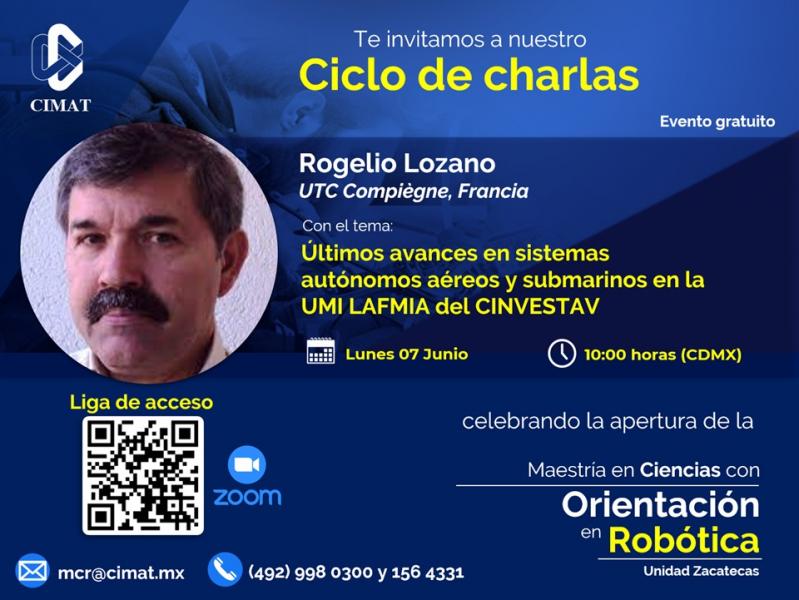
Université de Technologie de Compiégne, Francia
Fecha y hora: Lunes 07 Junio 2021, 10:00am (hora central de México).
Resumen
Se presentaran los trabajos de 5 estudiantes de doctorado sobre aviones convertibles con alas pivotantes, deteccion de agaves usando drones, helicopteros miniatura con plato ciclico electronico, uso de drones en deteccion de grietas, control de mini-submarinos.
Semblanza
Rogelio Lozano was born in Monterrey Mexico, on July 12, 1954. He received the B.S. degree in electronic engineering from the National Polytechnic Institute of Mexico in 1975, the M.S. degree in electrical engineering from Centro de Investigación y de Estudios Avanzados (CINVESTAV), Mexico in 1977, and the Ph.D. degree in automatic control from Laboratoire d'Automatique de Grenoble, France, in 1981. He joined the Department of Electrical Engineering at CINVESTAV, Mexico, in 1981 where he worked until 1989. He was Head of the Section of Automatic Control from June 1985 to August 1987. He has held visiting positions at the University of Newcastle, Australia, from November 1983 to November 1984, NASA Langley Research Center VA, from August 1987 to August 1988, and Laboratoire d'Automatique de Grenoble, France, from February 1989 to July 1990. Since 1990 he is a CNRS (Centre National de la Recherche Scientifique) Research Director at University of Technology of Compiègne, France. He was Associate Editor of Automatica in the period 1987-2000. He is associate Editor of the Journal of Intelligent and Robotics Systems since 2012 and Associate Editor in the Int. J. of Adaptive Control and Signal Processing since 1988.
He has coordinated or participated in numerous French projects dealing with UAVs. He has recently organized 2 international workshops on UAVs (IFAC RED UAS 2013 and IEEE RAS RED UAS 2015). He participates in the organization of the annual international conference ICUAS (International Conference on Unmanned Aerial Systems) since 2010. He is IPC Chairman of the ICSTCC in Rumania since 2012. He was Head of Heudiasyc Laboratory in the period 1995-2007 and since 2008 He is Head of the Joint Mexican-French UMI 3175 CNRS. His areas of expertise include UAVs, mini-submarines, exo-squelettons and Automatic Control. He has been the advisor or co-advisor of more than 35 PhD theses and published more than 130 international journal papers and 10 books.
Design, Modeling and Control of a Robot Bat: From Bio-inspiration to Engineering Solutions
- Dr. Seth Hutchinson
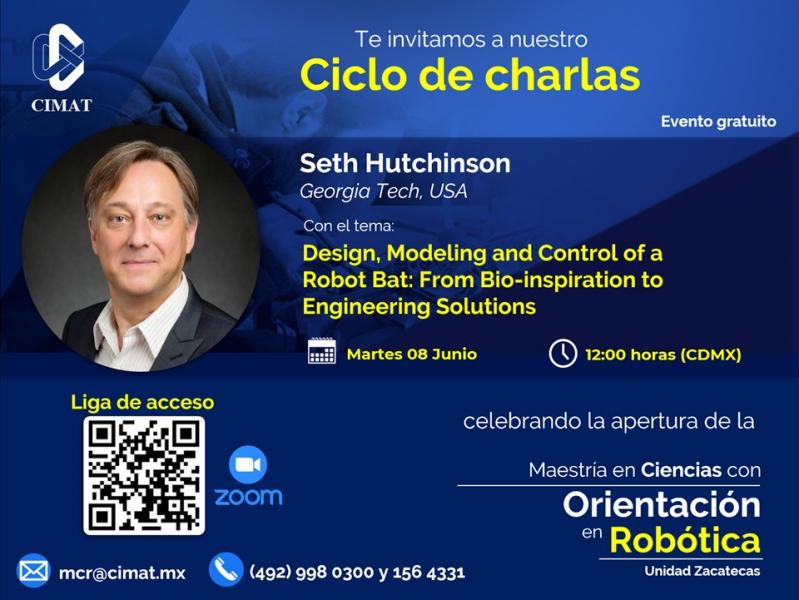
Georgia Institute of Technology
Fecha y hora: Martes 08 Junio 2021, 12:00pm (hora central de México)
Resumen
In this talk, I will describe our work building a biologically-inspired bat robot. Bats have a complex skeletal morphology, with both ball-and-socket and revolute joints that interconnect the bones and muscles to create a musculoskeletal system with over 40 degrees of freedom, some of which are passive. Replicating this biological system in a small, lightweight, low-power air vehicle is not only infeasible, but also undesirable; trajectory planning and control for such a system would be intractable, precluding any possibility for synthesizing complex agile maneuvers, or for real-time control. Thus, our goal is to design a robot whose kinematic structure is topologically much simpler than a bat's, while still providing the ability to mimic the bat-wing morphology during flapping flight, and to find optimal trajectories that exploit the natural system dynamics, enabling effective controller design.
The kinematic design of our robot is driven by motion capture experiments using live bats. In particular, we use principal component analysis to capture the essential bat-wing shape information, and solve a nonlinear optimization problem to determine the optimal kinematic parameters for a simplified parallel kinematic wing structure. We then derive the Lagrangian dynamic equations for this system, along with a model for the aerodynamic forces. We use a shooting-based optimizer to locate physically feasible, periodic solutions to this system, and an event-based control scheme is then derived in order to track the desired trajectory. We demonstrate our results with flight experiments on our robotic bat.
Semblanza
Seth Hutchinson is Professor and KUKA Chair for Robotics in the School of Interactive Computing at the Georgia Institute of Technology, where he also serves as Executive Director of the Institute for Robotics and Intelligent Machines. His research in robotics spans the areas of planning, sensing, and control. He has published more than 200 papers on these topics, and is coauthor of the books "Principles of Robot Motion: Theory, Algorithms, and Implementations," published by MIT Press, and "Robot Modeling and Control," published by Wiley.
Hutchinson is president of the IEEE Robotics and Automation Society. He currently serves on the editorial board of the International Journal of Robotics Research and chairs the steering committee of the IEEE Robotics and Automation Letters. He was Founding Editor-in-Chief of the IEEE Robotics and Automation Society's Conference Editorial Board (2006-2008) and Editor-in-Chief of the IEEE Transaction on Robotics (2008-2013).
Hutchinson is an Emeritus Professor of Electrical and Computer Engineering at the University of Illinois at Urbana-Champaign, where he was Professor of ECE until 2018, serving as Associate Head for Undergraduate Affairs from 2001 to 2007. He received his Ph.D. from Purdue University in 1988. Hutchinson is a Fellow of the IEEE.
https://www.cc.gatech.edu/~seth/
Robots visuales, nuevos sensores, algoritmos y modelos de interacción
- Dr. Walterio Mayol-Cuevas
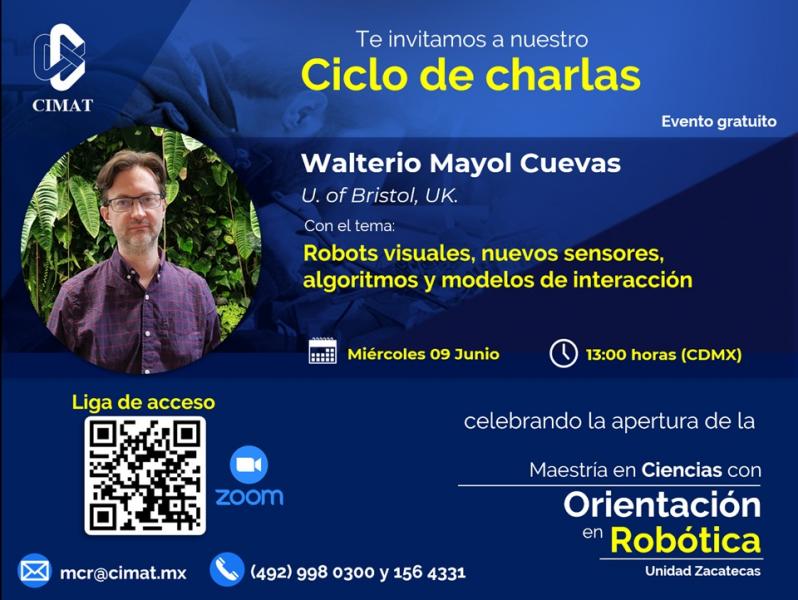
University Of Bristol, UK
Fecha y hora: Miércoles 09 Junio 2021, 1:00pm (hora central de México)
Resumen
En esta plática cubriré un poco del contexto de mi trabajo como investigador en los temas de visión por computadora, robótica y nuevos sensores para Robotica. En particular, hablaré de ejemplos de nuevos sensores paralelos para visión por computadora diseñados para procesamiento eficiente de información visual, detección de affordances por visión geométrica computacional y nuevos esquemas de interacción entre robots y personas.
Semblanza
Walterio W. Mayol Cuevas es actualmente Full Professor de la Universidad de Bristol en el Reino Unido, así como Principal Research Scientist en Amazon EUA. Obtuvo su licenciatura en la Facultad de Ingeniería de la UNAM y su DPhil en la Universidad de Oxford. Recibió el premio Nacional de la Juventud por Actividades Académicas, el HP Innovation Research Award, Samsung Global Outreach Award y premios y nominaciones a sus artículos en IEEE ICRA, BMVC y CHI. Ha fungido como General Chair del IEEE International Symposium of Mixed and Augmented Reality (ISMAR), y General co-Chair del British Machine Vision Conference (BMVC). Sus intereses incluyen nuevos tipos de robots, algoritmos de procesamiento visual, nuevos sensores y mecanismos de percepción visual.
Sesión informativa - Maestría en Ciencias con orientación en Robótica
Dr. Hugo A. Mitre-Hernandez y Dr. Diego A. Mercado-Ravell, CIMAT-Zacatecas
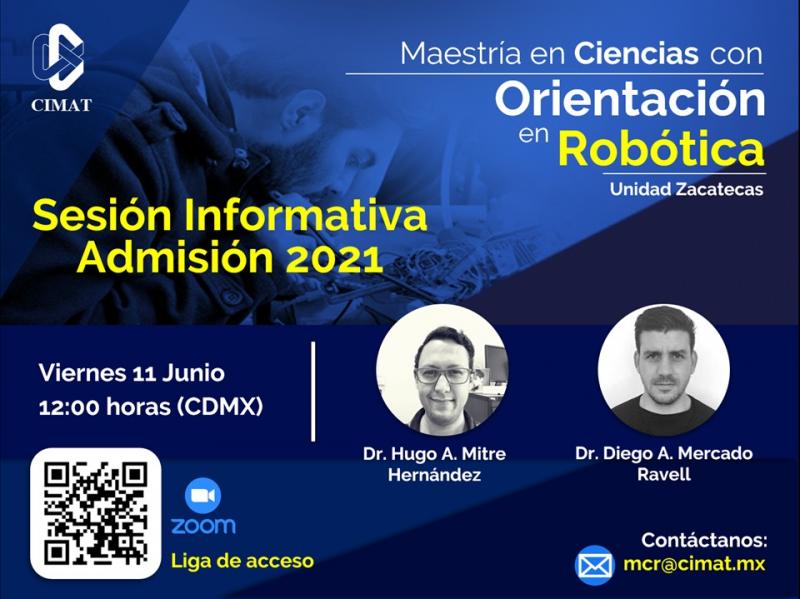
Fecha y hora: Viernes 11 Junio 2021, 12:00pm (hora central de México)
Resumen
En esta plática, se presenta el nuevo programa de maestría ofrecido por el equipo de Robótica de CIMAT, con sede en la unidad Zacatecas, y en estrecha colaboración con la unidad Guanajuato. Se presentará a detalle el núcleo académico, plan de estudios, objetivo, perfiles de ingreso y egreso, así como los proyectos de investigación que se podrán desarrollar durante el posgrado. Finalmente, se dará la información pertinente relativa al proceso de admisión del año en curso.
